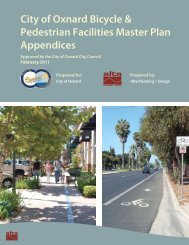View File - Development Services - City of Oxnard
View File - Development Services - City of Oxnard
View File - Development Services - City of Oxnard
Create successful ePaper yourself
Turn your PDF publications into a flip-book with our unique Google optimized e-Paper software.
6.0 GREAT Program Groundwater FlowModelingThis section evaluates those elements <strong>of</strong> the GREAT Program that will have a cumulative(year-to-year) regional effect on groundwater elevations within the aquifers underlying the<strong>Oxnard</strong> Plain and Pleasant Valley areas. These are the project elements related to creatingthe new sources <strong>of</strong> water supply, which would be created by reusing treated effluent fromthe <strong>City</strong> WWTP that is currently being discharged to the ocean. These consist <strong>of</strong> thefollowing elements, as summarized in Section 1.0 and described in Section 4.0:• In-Lieu Groundwater Recharge using Recycled Water• Direct Injection Groundwater Recharge using Recycled Water• Groundwater Recovery for Potable UseThe methodology used to evaluate the regional effects from implementing GREAT Programelements and the results <strong>of</strong> that evaluation are presented below.6.1 MethodologyThe regional effects on groundwater elevations are evaluated by developing and simulatingdetailed Phase 1 and Phase 2 operating scenarios for the GREAT Program using the updatedUWCD model <strong>of</strong> the USGS groundwater flow model <strong>of</strong> the Santa Clara-Calleguas Basin.The USGS model and the UWCD update to that model are described in Section 5.0.6.1.1 <strong>Development</strong> <strong>of</strong> ScenariosDetailed scenarios are developed for operation <strong>of</strong> Phase 1 and Phase 2 elements <strong>of</strong> theGREAT Program to (1) evaluate the cumulative effects on groundwater elevations and(2) evaluate extraction well locations to minimize coastal drawdown during groundwaterrecovery. The results <strong>of</strong> these scenarios are compared to a Base Case scenario, which wouldrepresent conditions without the GREAT Program. The Base Case, and the Phase 1 andPhase 2 scenarios, are described below and summarized in Table 6-1.Base Case ScenarioThe objective <strong>of</strong> the Base Case is to develop a No Project scenario against which the effects<strong>of</strong> the proposed GREAT Program Phase 1 and Phase 2 scenarios are compared. The BaseCase is developed and consists <strong>of</strong> the following elements:• Inland Saline Intrusion Assessment Project – Scenario 3. Scenario 3 from the InlandSaline Intrusion Assessment Project is used as a starting point. The scenario is describedin Section 5.0 and consists <strong>of</strong> the following:−Water deliveries from the UWCD Saticoy wellfield used as in-lieu deliveries to <strong>of</strong>fsetpumping demand in PTP and PVCWD wells.W112003002SCO LW1458.DOC/ 033390002 73
















